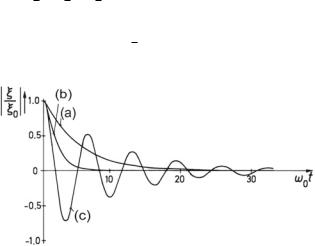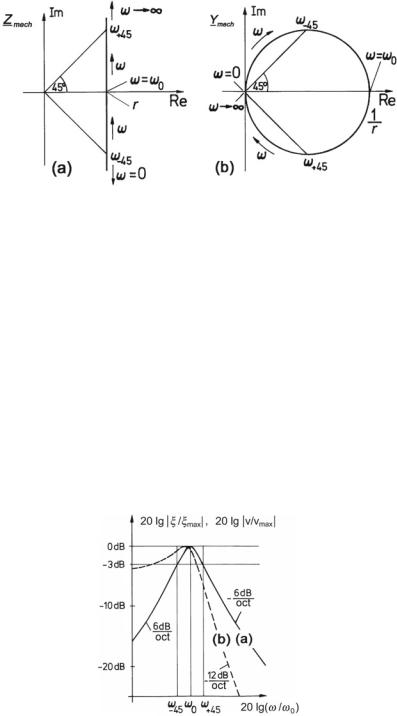
- •The Acoustical Society of America
- •Preface
- •Contents
- •About the Authors
- •1 Introduction
- •1.2 Specialized Areas within Acoustics
- •1.3 About the History of Acoustics
- •1.4 Relevant Quantities in Acoustics
- •1.5 Some Numerical Examples
- •1.6 Logarithmic Level Ratios and Logarithmic Frequency Ratios
- •1.7 Double-Logarithmic Plots
- •1.8 Exercises
- •2 Mechanic and Acoustic Oscillations
- •2.1 Basic Elements of Linear, Oscillating, Mechanic Systems
- •2.2 Parallel Mechanic Oscillators
- •2.3 Free Oscillations of Parallel Mechanic Oscillators
- •2.4 Forced Oscillation of Parallel Mechanic Oscillators
- •2.5 Energies and Dissipation Losses
- •2.6 Basic Elements of Linear, Oscillating, Acoustic Systems
- •2.7 The Helmholtz Resonator
- •2.8 Exercises
- •3.1 The Electromechanic Analogies
- •3.2 The Electroacoustic Analogy
- •3.3 Levers and Transformers
- •3.4 Rules for Deriving Analog Electric Circuits
- •3.5 Synopsis of Electric Analogies of Simple Oscillators
- •3.6 Circuit Fidelity, Impedance Fidelity and Duality
- •3.7 Examples of Mechanic and Acoustic Oscillators
- •3.8 Exercises
- •4.2 The Carbon Microphone—A Controlled Coupler
- •4.3 Fundamental Equations of Electroacoustic Transducers
- •4.4 Reversibility
- •4.5 Coupling of Electroacoustic Transducers to the Sound Field
- •4.6 Pressure and Pressure-Gradient Receivers
- •4.7 Further Directional Characteristics
- •4.8 Absolute Calibration of Transducers
- •4.9 Exercises
- •5 Magnetic-Field Transducers
- •5.1 The Magnetodynamic Transduction Principle
- •5.2 Magnetodynamic Sound Emitters and Receivers
- •5.3 The Electromagnetic Transduction Principle
- •5.4 Electromagnetic Sound Emitters and Receivers
- •5.5 The Magnetostrictive Transduction Principle
- •5.6 Magnetostrictive Sound Transmitters and Receivers
- •5.7 Exercises
- •6 Electric-Field Transducers
- •6.1 The Piezoelectric Transduction Principle
- •6.2 Piezoelectric Sound Emitters and Receivers
- •6.3 The Electrostrictive Transduction Principle
- •6.4 Electrostrictive Sound Emitters and Receivers
- •6.5 The Dielectric Transduction Principle
- •6.6 Dielectric Sound Emitters and Receivers
- •6.7 Further Transducer and Coupler Principles
- •6.8 Exercises
- •7 The Wave Equation in Fluids
- •7.1 Derivation of the One-Dimensional Wave Equation
- •7.3 Solutions of the Wave Equation
- •7.4 Field Impedance and Power Transport in Plane Waves
- •7.6 The Acoustic Measuring Tube
- •7.7 Exercises
- •8 Horns and Stepped Ducts
- •8.2 Conical Horns
- •8.3 Exponential Horns
- •8.4 Radiation Impedances and Sound Radiation
- •8.5 Steps in the Area Function
- •8.6 Stepped Ducts
- •8.7 Exercises
- •9.1 The Spherical Wave Equation
- •9.2 Spherical Sound Sources of the First Order
- •9.3 Spherical Harmonics
- •9.4 Higher-Order Spherical Sound Sources
- •9.5 Line Arrays of Monopoles
- •9.6 Analogies to Fourier Transform in Signal Theory
- •9.7 Directional Equivalence of Sources and Receivers
- •9.8 Exercises
- •10.1 The Rayleigh Integral
- •10.3 The Far-Field of Piston Membranes
- •10.4 The Near-Field of Piston Membranes
- •10.5 General Remarks on Diffraction and Scattering
- •10.6 Exercises
- •11.1 Dissipation During Sound Propagation in Air
- •11.2 Sound Propagation in Porous Media
- •11.4 Wall (Surface) Impedance and Degree of Absorption
- •11.5 Porous Absorbers
- •11.6 Resonance Absorbers
- •11.7 Exercises
- •12.1 Mirror Sound Sources and Ray Tracing
- •12.2 Flutter Echoes
- •12.3 Impulse Responses of Rectangular Rooms
- •12.4 Diffuse Sound Fields
- •12.5 Reverberation-Time Formulas
- •12.6 Application of Diffuse Sound Fields
- •12.7 Exercises
- •13.1 Sound in Solids—Structure-Borne Sound
- •13.2 Radiation of Airborne Sound by Bending Waves
- •13.3 Sound-Transmission Loss of Single-Leaf Walls
- •13.4 Sound-Transmission Loss of Double-Leaf Walls
- •13.5 The Weighted Sound-Reduction Index
- •13.6 Insulation of Vibrations
- •13.7 Insulation of Floors with Regard to Impact Sounds
- •13.8 Exercises
- •14 Noise Control—A Survey
- •14.1 Origins of Noise
- •14.2 Radiation of Noise
- •14.3 Noise Reduction as a System Problem
- •14.4 Noise Reduction at the Source
- •14.5 Noise Reduction Along the Propagation Paths
- •14.6 Exercises
- •15 Solutions to the Exercise Problems
- •16 Appendices
- •16.1 Complex Notation of Sinusoidal Signals
- •16.2 Complex Notation of Power and Intensity
- •16.3 Supplementary Textbooks for Self Study
- •16.4 Letter Symbols, Notations, and Units
- •Index

2.3 Free Oscillations of Parallel Mechanic Oscillators |
19 |
2.3 Free Oscillations of Parallel Mechanic Oscillators
This section deals with the particular case that the oscillator is in a position away from its resting position, and the introduced force is set to zero, that is, F (t ) = 0 for t > 0. The differential equation (2.13) then converts into a homogenous differential equation as follows,
d2ξ |
|
dξ |
1 |
|
|
||
m |
|
+ r |
|
+ |
|
ξ = 0 . |
(2.14) |
dt 2 |
dt |
n |
|||||
The solution of this equation is called free oscillation or eigen-oscillation of the system. A trial using ξ = e st results in the characteristic equation3
m s2 |
1 |
= 0 , |
|
+ r s + n |
(2.15) |
where s denotes the complex frequency. The general solution of this quadratic equation reads as
|
r |
|
r 2 |
1 |
|
|
|
|
|
± |
or s 1, 2 = −δ ± δ2 − ω02 , (2.16) |
||||||
s 1, 2 = − |
|
|
− |
|
||||
2 m |
4 m2 |
m n |
||||||
√
where δ = r/2m is the damping coefficient and ω0 = 1/ m n the characteristic angular frequency. This general form renders the three different types of solutions, namely,
Case (a) with δ = ω0 ... critical damping, only one root, which is real. Case (b) with δ > ω0 ... strong damping, both roots real, s is negative. Case (c) with δ < ω0 ... weak damping, both roots are complex.
The differential equation for a simple oscillator is of second order, making it necessary to have two initial conditions to derive specific solutions. Three forms of general solutions exist, which are listed below. It remains to adjust them to the particular initial conditions to finally arrive at particular solutions.
• Case (a) (δ = ω0)
ξ |
(t ) = ( |
ξ |
1 + |
ξ |
2) e−δt . |
(2.17) |
|
|
|
|
This case is at the brink of both periodic and aperiodic decay. Depending on the initial conditions, it may or may not render a single swing-over. It is called the aperiodic limiting case.
• Case (b) (δ > ω0) |
|
ξ(t ) = ξ 1 e−(δ−√δ2 −ω02 )t + ξ 2 e−(δ+√δ2 −ω02 )t . |
(2.18) |
3 As noted in the introduction to this chapter, the general exponential function is an eigen-function of linear differential equations. This means that it stays to be an exponential function when differentiated or integrated.

20 |
|
|
|
|
|
|
2 Mechanic and Acoustic Oscillations |
|||
This solution, called the creeping case, describes an aperiodic decay. |
|
|||||||||
• Case (c) (δ < ω0) |
|
|
|
|
||||||
|
ξ |
(t ) = |
ξ |
1 e−δt e−jωt + |
ξ |
2 e−δt e+jωt , |
with ω = ω02 − δ2 . |
(2.19) |
||
|
|
|
|
|
||||||
This solution, called the oscillating case, describes a periodic, decaying oscillation. It represents indeed an oscillation as illustrated by looking at the particular special case of ξ 1 = ξ 2 = ξ 1, 2/2.
Substituting it into (2.19) yields |
|
ξ(t ) = ξ 1, 2 e−δt cos(ωt ) |
(2.20) |
Fig. 2.3 Decays of a simple oscillator for different damping settings (schematic). (a) Aperiodic limiting case. (b) Aperiodic case. (c) Oscillating case
Figure 2.3 illustrates the three cases. The fastest-possible decay below a threshold— which, by the way, is the objective when tuning the suspension of road vehicles—is achieved with a slightly subcritical damping of δ ≈ 0.6 ω0.
In addition to δ = r/2m, the following two quantities are often used in acoustics to characterize the amount of damping in an oscillating system,
Q… The sharpness-of-resonance factor, also known as quality factor.
Td … The decay time—similar to the reverberation time in Sect. 12.5.
The sharpness-of-resonance factor, Q, is defined as |
|
||||
Q = |
ω0 |
= |
ω0 m |
, |
(2.21) |
2 δ |
r |
||||
It is a measure of the width of the peak of the resonance curve—compare Fig. 2.6. A more illustrative interpretation is possible in the time domain when one considers that after Q oscillations a mildly damped oscillation has decreased to 4 % of its starting value—which is at the brink of what is visually detectable on an oscilloscope
screen.

2.3 Free Oscillations of Parallel Mechanic Oscillators |
21 |
|
Table 2.1 Typical Q values for various oscillators |
|
|
|
|
|
Type of element |
Quality factor |
|
|
|
|
Electric oscillator of traditional construction |
Q ≈ 102–103 |
|
(coil, capacitor, resistor) |
|
|
Electromagnetic cavity oscillator |
Q ≈ 103–106 |
|
Mechanic oscillator, steel in vacuum |
Q ≈ 5 · 103 |
|
Quartz oscillator in vacuum |
Q ≈ 5 · 105 |
|
The decay time, Td, measures how long it takes for an oscillation to decrease by 60 dB after the excitation has been stopped. At this level, the velocity and displacement have decayed to one-thousandth and the power to one-millionth of its original value. Td and δ are related by Td ≈ 6.9/δ—see Sect. 12.5.
Table 2.1 lists characteristic Q values for different kinds of technologically relevant oscillators. For comparison, in the aperiodic limiting case, Q has a value of 0.5.
2.4 Forced Oscillation of Parallel Mechanic Oscillators
For free oscillations, the exciting force is zero. Yet, in this section we now deal with the case where the oscillator is driven by an ongoing sinusoidal force, F (t ) =
ˆ |
ω |
t |
+ φ |
4 |
= ω |
/2 |
π |
, such that the oscillation |
F cos( |
|
|
), with an angular frequency of f |
|
|
of the system takes on a stationary state. This mode of operation is termed forcedriven or forced oscillation. The mathematical description leads to an inhomogeneous differential equation as follows,
|
|
F cos( |
|
t |
|
) |
|
|
m |
d2ξ |
|
|
|
r |
dξ |
1 |
|
. |
(2.22) |
||||||
|
|
|
|
|
|
|
|
|
|
|
|
|
|
|
|
||||||||||
ω |
+ φ |
= |
dt 2 |
+ |
|
dt |
+ n |
ξ |
|||||||||||||||||
|
|
ˆ |
|
|
|
|
|
|
|
|
|||||||||||||||
For sinusoidal excitations, this equation reads as follows in complex form, |
|
||||||||||||||||||||||||
|
|
F = −ω2m |
|
|
|
|
|
|
|
|
1 |
|
|
|
|
|
|
|
|||||||
|
|
ξ |
+ j ω r |
ξ |
+ |
|
ξ . |
|
|
(2.23) |
|||||||||||||||
n |
|
|
|||||||||||||||||||||||
|
|
|
|
|
|
|
|
|
|
||||||||||||||||
Substitution of ξ by v yields |
|
|
|
|
|
|
|
|
|
|
|
|
|
|
|
|
|
|
|
|
|
|
|||
|
|
F = j ω m v + r v + |
|
|
1 |
|
v . |
|
|
(2.24) |
|||||||||||||||
|
|
|
|
|
|||||||||||||||||||||
|
|
j ω n |
|
|
|||||||||||||||||||||
This equation directly admits the inclusion of the mechanic impedance, Z mech, as well as it’s reciprocal, the mechanic admittance (also termed mobility), Y mech = 1/Z mech, so that
4 Slowly varying frequencies are also in use, assuming that a stationary state has (approximately) been reached at each instant of observation.

22 |
2 Mechanic and Acoustic Oscillations |
Fig. 2.4 Trajectories of mechanic impedance/admittance in the complex Z and Y planes as functions of angular frequency. (a) Mechanic impedance. (b) Mechanic admittance (mobility)
|
F |
|
|
|
1 |
|
|
|
|
|
|
Z mech = |
|
|
= j ω m + r + |
|
|
|
|
and |
(2.25) |
||
v |
j ω n |
||||||||||
Y mech = |
|
v |
= |
1 |
|
|
|
|
. |
(2.26) |
|
|
|
|
|
|
|||||||
|
F |
1 |
|
||||||||
|
|
|
|
|
j ω m + r + |
j ω n |
|
|
|
||
Figure 2.4 illustrates the trajectories of these two quantities in the complex plane as a function of frequency. The two quantities become real at the characteristic frequency, ω0. At this frequency, the phase changes signs (jumps) from positive to negative values or vice versa.
Figure 2.5 schematically illustrates functions of ξ(ω) and v(ω) in the case of slow variations of the frequency of excitation. For simple oscillators these curves have a single peak. In this example, for a case of subcritical damping with Q ≈ 2, the exciting force is kept constant over frequency.
Fig. 2.5 Mechanic responses of a simple resonator as a function of the angular frequency for constant-amplitude forced excitation. (a) Velocity. (b) Displacement

2.4 Forced Oscillation of Parallel Mechanic Oscillators |
23 |
For the velocity curve, the two points at -3 dB correspond to the frequency ω−45 and ω45. The difference of these frequencies,
ω = ω45 − ω−45 |
(2.27) |
is termed (angular frequency) bandwidth.
The quality factor, Q, is determined by this bandwidth as
Q = |
ω0 |
(2.28) |
ω . |
√
For Q ≤ 1/ 2, a displacement resonance does not occur. The course of calculations to arrive at these functions is as follows,
F |
|
F |
1 |
|
+ r, |
|
||||||||||||||||||||
|
|
|
|
= |
|
|
|
|
|
|
|
= j ω m + |
|
|
(2.29) |
|||||||||||
v |
j ω ξ |
j ω n |
||||||||||||||||||||||||
|
|
|
|
|
|
ξ |
|
= |
|
|
1 |
|
|
|
|
, |
|
|
(2.30) |
|||||||
|
|
|
|
|
|
|
|
|
|
|
|
|
|
|
|
|||||||||||
|
|
|
|
|
F |
−ω2m + n1 + j ω r |
|
|||||||||||||||||||
| ξ | |
|
|
|
|
1 |
|
|
|
|
|
|
|
||||||||||||||
|
|
|
|
= |
|
|
|
|
|
|
|
, |
(2.31) |
|||||||||||||
| |
F |
| |
|
|
|
|
|
|
|
|||||||||||||||||
|
|
( n1 − ω2m)2 + (ωr )2 |
||||||||||||||||||||||||
|
|
| v | |
= |
|
1 |
|
|
|
. |
|
(2.32) |
|||||||||||||||
|
|
| F | |
|
|
|
|
|
|
|
|
|
|
|
|||||||||||||
|
|
|
|
|
|
|
|
1 |
|
|
|
|
|
|||||||||||||
|
|
|
|
|
|
|
(ωm − |
)2 + r 2 |
|
|
||||||||||||||||
|
|
|
|
|
|
|
ωn |
|
|
|||||||||||||||||
Note that the phase of the velocity, v, is decreasing and passes zero at ω0, while the phase of the displacement, ξ, is also decreasing but goes through −π/2 at this point— see Fig. 2.6. Furthermore, the position of the peak for the |v(ω)| curve is precisely at the characteristic frequency, while the peak of the |ξ(ω)| curve lies slightly lower— the higher the damping, the lower the frequency at this peak! Hence, this peak is called the resonance. Consequently, it should be distinguished appropriately between the terms resonance frequency and characteristic frequency.
Figure 2.6 shows the resonance curves for the velocity in a slightly different way to illustrate the role of the Q-factor concerning the form of these curves. The resonance peak becomes higher and more narrow with increasing Q. This is the reason that Q is termed sharpness-of-resonance factor, besides quality factor.
